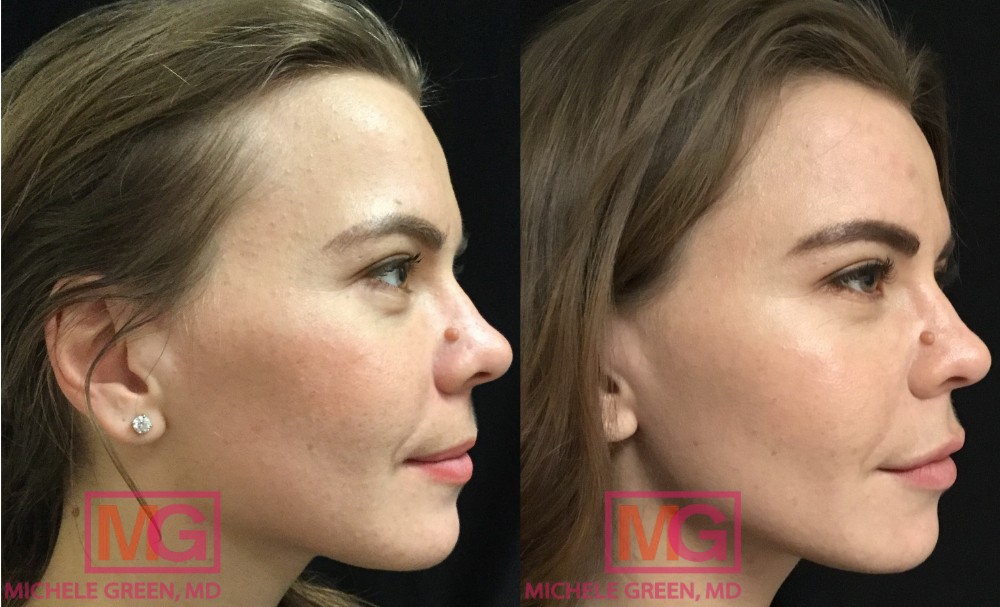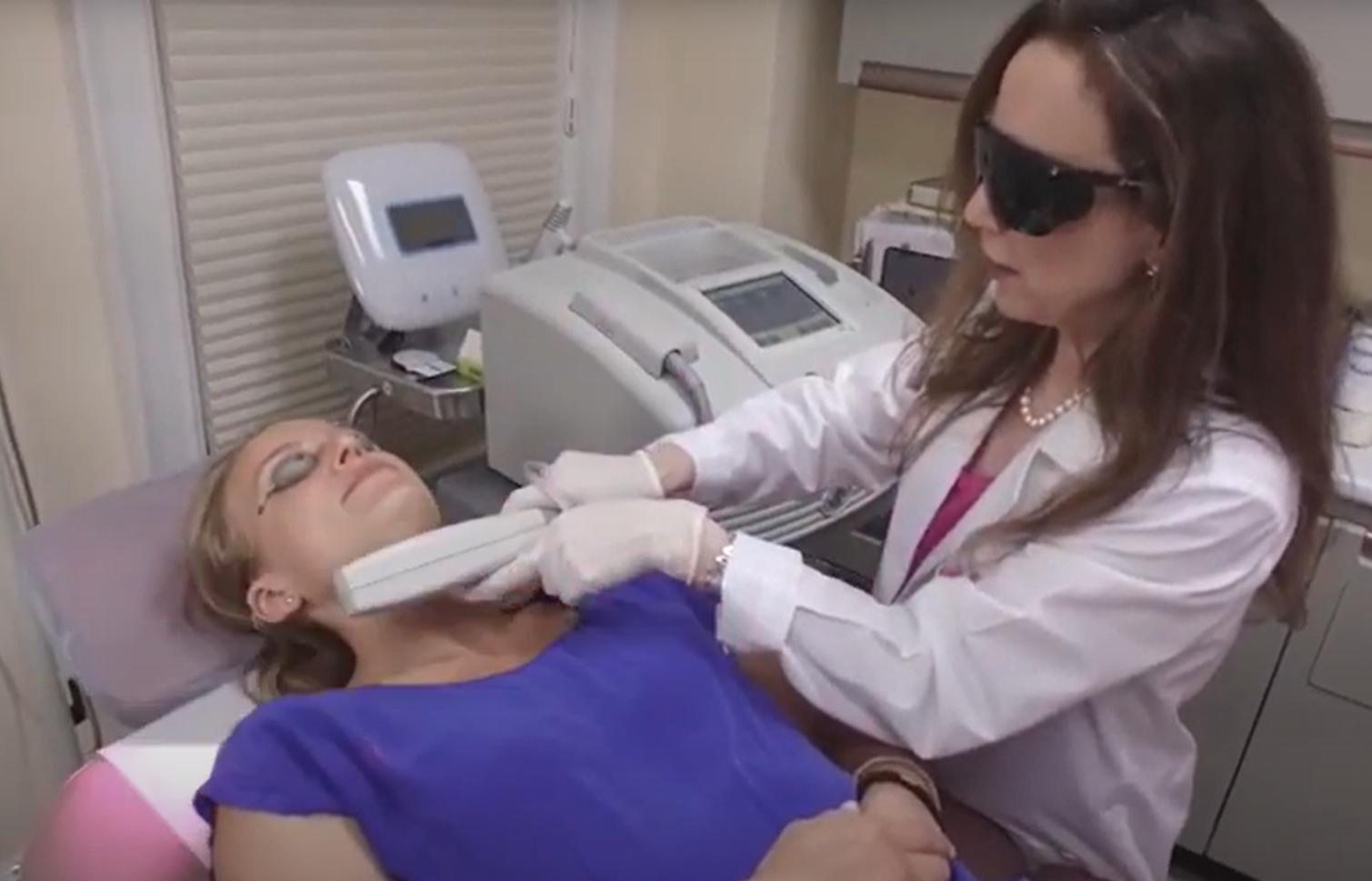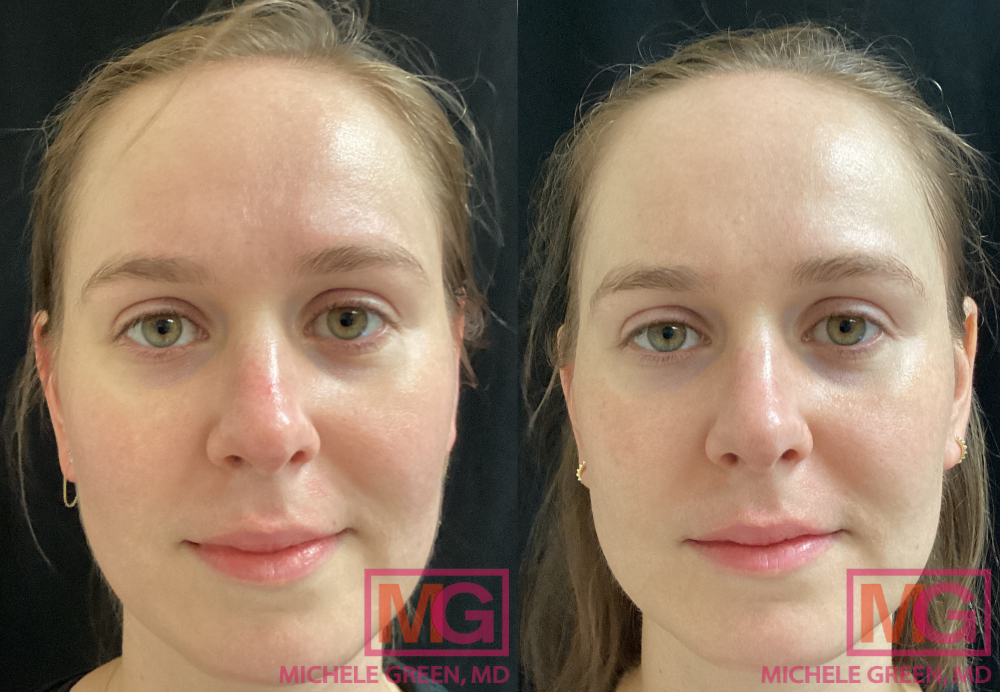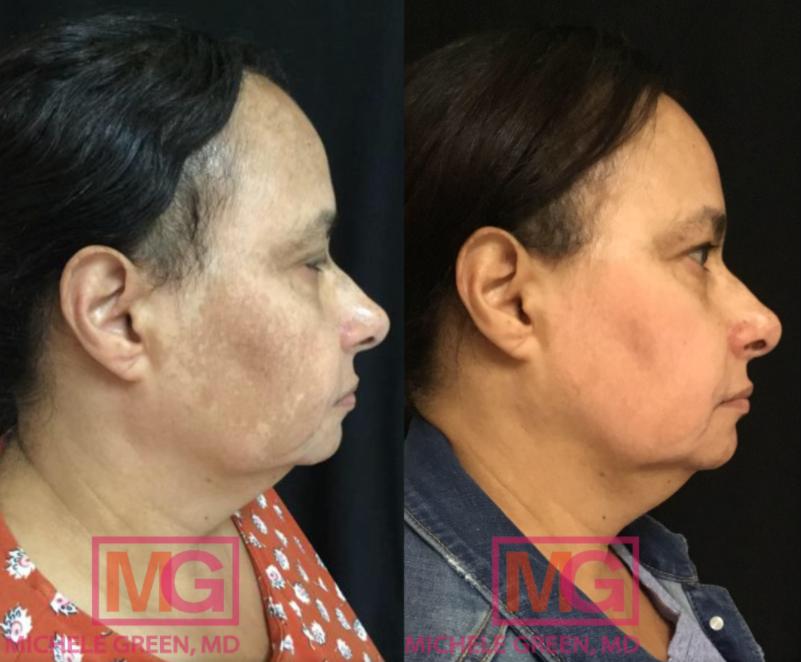Laser Toning
Hyperpigmentation on the skin, including age spots, melasma, acne scars, rosacea, birthmarks, and freckles, can contribute to an uneven skin tone that makes patients self-conscious. This discoloration on the skin can also be a distressing sign of the natural aging process along with fine lines, wrinkles, loose skin, and uneven skin texture, skin conditions that will not fade on their own. Unprotected sun exposure can exacerbate these skin concerns, leading to sun damage and making effective treatment more challenging. Seeking safe and effective treatment options is essential, as specific laser skin treatments, including ablative lasers, may worsen conditions like melasma and rosacea. High-fluence, concentrated laser energy can lead to hypopigmentation and relapse of these skin conditions. That is why it is always best to consult with an expert, board-certified dermatologist, such as Dr. Michele Green, who can recommend a treatment plan that will be safest and most effective for hyperpigmentation, such as laser toning.
Laser toning is a technique that uses low-fluence laser emissions over several treatment sessions to treat hyperpigmentation, including sun spots, uneven skin tone, and melasma. The non-ablative laser technique does not refer to one specific type of laser. Instead, laser toning can describe any low-level laser treatment performed 5-15 times to achieve the best results. Typically, laser toning is completed with a q-switched Nd: Yag laser, but it can also be performed with a picosecond laser or intense pulsed light (IPL). With short pulses of energy penetrating the deeper dermal layers of skin, laser toning destroys pigmentation to erase blemishes, discoloration, and lesions without damaging surrounding tissue or the epidermis, meaning the risk of developing side effects is low, and there is no recovery time associated with the treatment. To find out which type of laser is best for your laser toning treatment, schedule a consultation with Dr. Michele Green today.
Board-certified dermatologist Dr. Michele Green has been expertly treating patients in her Upper East Side New York City dermatology office for more than 25 years. Highly experienced in many treatment options, including dermal fillers, chemical peels, Microneedling, Botox, and laser treatments for hyperpigmentation, skin rejuvenation, hair removal, and more, Dr. Green is a master at creating individualized treatment plans based on each patient’s aesthetic goals. With her proprietary skincare company, MGSKINLABs, Dr. Green can also recommend the highest quality topical creams, lotions, and gels to pair with any anti-aging treatment to improve results. Well-known for high patient satisfaction, Dr. Green has been voted one of the best healthcare providers in New York City by such publications as Castle Connolly, New York Magazine, and Super Doctors.
What is laser toning treatment?
Laser toning is a treatment technique designed to erase dark spots on the skin without damaging the surrounding tissue or requiring any downtime. The goal of the treatment is to even out the skin tone and eliminate the appearance of hyperpigmentation on the skin. Laser toning treatment does not describe a specific brand of laser. Instead, laser toning is a treatment method in which low-fluence wavelengths of laser energy are applied to the treatment area over multiple treatments spaced one to two weeks apart. Unlike other skin resurfacing laser treatments, this method allows for the destruction of pigmentation in the dermis – or inner layer of skin – without causing damage to the epidermis. The technique was initially used for treating melasma without as much risk of developing worsening symptoms or hypopigmentation when white spots appear on the skin’s surface.

How does laser skin rejuvenation work?
Over time, dark spots may develop on the skin’s surface due to a skin condition, such as melasma, or sun damage in the form of sunspots. This hyperpigmentation occurs when there is uneven, overactive production of the pigment melanin, merging to form discolored blemishes on the skin. Many forms of laser treatment for skin resurfacing are used to eliminate dark spots and provide patients with an even skin tone. Many laser treatment options use high fluence emissions, meaning high concentrations of laser energy that heat the inner layer of the skin to destroy the melanocytes and boost collagen production. These high-fluence lasers, while effective, can be dangerous for patients with darker skin, potentially leading to post-inflammatory hyperpigmentation, and for patients with melasma, potentially worsening the symptoms of the skin condition and causing hypopigmentation. With this disclaimer in mind, Dr. Green may turn to laser toning, which uses low-fluence laser emissions and is safe for all skin types. By reducing the intensity of the laser energy, laser toning destroys melanosomes (rather than melanocytes), which reduces pigmentation without the risk of surrounding cell death. When the melanosomes are eliminated, it triggers the body’s natural collagen production process, which helps to improve skin tone and texture for a smoother, more youthful appearance.
What does laser toning do?
Laser toning treats a variety of skin conditions and can be used for:
- Eliminating blemishes and hyperpigmentation
- Reducing the symptoms of melasma
- Erasing acne scars
- Improving skin tone
- Improving skin texture
Laser toning was initially developed as a third-line treatment for melasma that could be used when topical creams, sunscreens, and chemical peels were insufficient to reduce the symptoms. Laser toning is particularly effective for dermal or mixed melasma, meaning melasma with pigmentation that extends into the dermal layer of skin. The laser toning treatment can penetrate the deeper layers of the skin without causing any damage to the epidermis to break up pigmentation and reduce the appearance of dark spots on the skin’s surface.
How is laser toning done?
Laser toning is a quick and straightforward procedure in Dr. Green’s Upper East Side New York City dermatology office. After your initial consultation, where Dr. Green will examine the treatment area and determine your treatment plan, Dr. Green will select the type of laser that best meets your needs. Dr. Green will adjust the settings on the laser to achieve low fluence emissions (1064 nm on a q-switched laser) before applying the handpiece perpendicularly to the skin. Most patients do not feel significant discomfort during the treatment itself, though Dr. Green may apply a topical numbing cream to reduce the likelihood of feeling any pain. Each treatment session lasts only 20-30 minutes, but the laser toning should be performed 5-15 times every one to two weeks for the best results. Following the procedure, patients should use a broad-spectrum sunscreen with an SPF of at least 30 to protect the skin from new or worsening hyperpigmentation.

What types of laser toning work for facial rejuvenation?
As “Laser Toning” does not apply to a specific brand or type of laser, many different kinds of lasers can be used for laser toning, including:
Spectra Laser – The Spectra Laser, including Spectra Gold Laser, can be used in laser toning to address hyperpigmentation, uneven skin tone, and melasma. The Spectra Laser is a gentle q-switched Nd: YAG laser, which emits light wavelengths that penetrate the dermal layer of skin. With a 1064 nm wavelength, the Spectra laser can target pigment cells, causing them to shatter into fragments that are absorbed and metabolized by the body, eliminating the appearance of dark spots. The treatment also boosts collagen production in the area, promoting smoother, clearer skin.
Picosecond Lasers – Picosecond lasers differ from other laser treatments because they employ acoustic rather than thermal energy to destroy melanin cells and eliminate pigmentation. These lasers emit ultra-short bursts of light energy that vibrate the pigment cells in the dermis, causing them to shatter. Without thermal energy, picosecond lasers are safe and effective for patients of all skin types.
Intense Pulsed Light (IPL) – Intense Pulsed Light – or IPL – treatment works via the emission of many different wavelengths of light that are absorbed into the pigmented cells in the dermis. The treatment can address many skin conditions, including sun spots, freckles, birthmarks, acne scars, active acne breakouts, fine lines, and over-large pores. IPL is not the ideal treatment for melasma, as phototherapies, such as IPL, can worsen melasma symptoms.
What is the Pico toning laser?
The Picosecond laser was initially FDA-approved for tattoo removal and was unique in its ability to remove all ink colors, including sunset tones that are notoriously hard to remove. Picotoning uses picosecond laser technology to improve skin tone and texture. It is safe for all skin types, as the picosecond laser does not use heat to destroy pigmentation. Instead, lasers used in Picotoning employ ultra-short bursts of light energy that vibrate the pigmented cells, causing them to be destroyed without damaging the surrounding tissue. The high speed of the picosecond emissions reduces the risk of patient discomfort during treatment and the development of side effects post-treatment. With Picotoning laser treatment, patients can immediately return to their regularly scheduled activities without downtime.
What is the blue toning laser?
The Blue toning laser is a q-switched laser that uses twin pulses of energy emitted in short intervals to target pigment cells in the dermal layer of skin. Similarly to other types of q-switched lasers, the Blue toning laser energy shatters the pigmentation into smaller fragments that are absorbed and metabolized by the body. In addition to addressing hyperpigmentation issues, the Blue toning laser can address active acne breakouts by killing the bacteria responsible for acne and reducing pore size. With this gentle laser, several treatment sessions are necessary for optimal results.
How many sessions of laser toning for hyperpigmentation?
The number of treatment sessions necessary for hyperpigmentation depends on several factors, including the size and scope of the treatment area, the type of laser used, and the skin condition being treated. Most patients will require between 5 and 15 treatment sessions spaced approximately one week apart to achieve the best results. Due to the low-fluence emissions used in laser toning, the treatment works longer, reducing the risk of adverse events.
How many sessions of laser toning for IPL?
Intense Pulsed Light treatment effectively addresses numerous skin discoloration concerns, including acne scars, age spots, hyperpigmentation, freckles, and birthmarks, by emitting multiple wavelengths of light. The number of treatment sessions varies from patient to patient, but typically, Dr. Green recommends 4-6 treatment sessions to achieve the best results. After your initial consultation, Dr. Green will provide a closer estimate of the sessions necessary to meet your aesthetic goals.
How many sessions of laser toning for the lips?
Some patients are looking for a way to lighten their lips and may turn to laser toning as an effective treatment option. Using the laser toning method on the lips can boost collagen production and lighten the lips for a smooth, naturally youthful look. The number of treatment sessions varies when treating the lips, but typically, the lips require 3-4 treatment sessions for optimal results.
How long does laser toning last?
Laser toning is a gentle treatment with results that can last for a long time. For most patients, achieving optimal results will take between 5 and 15 treatment sessions, each spaced about a week apart. Patients will be able to see the effects of the treatment within several weeks of beginning the procedure. With proper skincare post-treatment, including the application of prescribed topical creams and sunscreens, the results should be visible for at least 12 months.

Is laser toning permanent?
Laser toning destroys pigment cells in the treatment area to reduce the appearance of dark spots on the skin’s surface and provide patients with a more even skin texture and tone. While the specific cells targeted during treatment are permanently destroyed, there is a risk of developing hyperpigmentation again. Repeated sun exposure can lead to new or worsening discoloration on the skin, so wearing a broad-spectrum SPF 30 sunscreen is extremely important whenever you go outside. Patients with melasma may experience a relapse of the condition when the laser toning treatment is finished. As such, Dr. Green will often pair laser toning therapy with a topical treatment to maintain the results over time.
Is laser toning painful?
Laser toning is a procedure that is associated with minimal discomfort during and after the treatment. Most patients do not feel any pain during the laser treatment. Still, Dr. Green will often apply a topical numbing cream before the procedure to reduce the risk of experiencing any discomfort. After the treatment, patients may experience mild side effects, such as redness at the treatment site. However, these side effects should go away within 48 hours of treatment.
Is laser toning safe?
Unlike other laser treatment options, laser toning is safe and effective for all skin types, including for patients with darker skin. Laser toning is a gentle treatment that uses low-fluence laser emissions over multiple treatment sessions to destroy pigmentation in the dermal layer of the skin without causing damage to the surrounding tissue. Laser toning is also safer for patients with melasma than other forms of laser treatment, as there is a lower risk of developing hypopigmentation post-treatment with laser toning.
Does laser toning cause acne?
Laser toning is not associated with acne breakouts. Some forms of laser toning treatment can help to combat active acne breakouts. For example, Blue toning laser therapy can kill the P-acne bacteria responsible for forming pimples. The laser treatment can also reduce the size of oil glands, preventing future breakouts, as acne can develop due to excess oil clogging the pores.
Does laser toning lighten the skin?
Laser toning lightens the skin, providing patients with a smooth, bright skin tone. Dark spots can form on the skin’s surface due to sun exposure or conditions like melasma. When patients spend time in the sun without sunscreen or other forms of sun protection, melanin production increases to prevent damage to the DNA in the skin, leading to dark spots on the skin’s surface. Laser toning can destroy the pigmented cells without damaging the epidermal layer of skin or surrounding tissue.

How much does laser toning cost?
The total cost of laser toning treatment depends on various factors, including the type of laser used for treatment, the size and scope of the treatment area, the number of treatment sessions necessary, the kind of institution at which you receive treatment, and your geographic location. When you have your initial consultation with Dr. Green, she will examine the treatment area, and you will have an open conversation about your treatment goals so she can determine the type of laser that will be best for you. Dr. Green may also recommend pairing laser toning with topical skincare products or injectable treatments, such as Botox or dermal fillers, for a full anti-aging effect. After your consultation, Dr. Green’s office will provide you with a better estimate of the total cost of the procedure based on your treatment plan. The type of institution at which you seek treatment also affects the total cost of the treatment. While an institution like MedSpa may have lower prices, the likelihood of developing adverse side effects is higher when you seek treatment from a practitioner other than a board-certified dermatologist. That is why seeking treatment from an expert dermatologist like Dr. Green is essential.
What is laser toning for the face?
Laser toning is an effective treatment for facial hyperpigmentation, including age spots, blemishes, acne scars, birthmarks, freckles, and melasma. Laser toning is a gentle treatment option, providing patients with improved skin tone and texture without causing damage to the surrounding tissue. No downtime is required after the treatment, and with lower fluence energy emissions, there is a lower risk of adverse events, such as hypopigmentation. The treatment is safe and effective for all skin types, making it a popular treatment option.
Why is toning your face important?
While many hyperpigmentation skin conditions are not harmful to your health, dark spots on prominent locations, such as the face, can negatively affect self-esteem. When treating the face, it is essential to choose a treatment option that is safe and effective for your skin type to avoid post-inflammatory hyperpigmentation, hypopigmentation, or worsening of an existing skin condition like melasma. Seeking treatment from a board-certified dermatologist, such as Dr. Green, ensures that your treatment plan is right for you, providing you with smooth, clear, bright, and youthful-looking skin.
Is laser toning effective?
In recent years, laser toning has been extensively studied to determine how effective it is in reducing hyperpigmentation and melasma symptoms. Across many studies, laser treatment has been demonstrated to be a highly effective treatment option for patients looking to reduce discoloration on the skin, especially when paired with topical treatments, such as hydroquinone cream, azelaic acid cream, and chemical peels. One study conducted by Sim et al. reported an improvement rate of 50-74% for the 50 patients who received 15 treatment sessions weekly. In a study published by Tian, researchers provided laser toning treatment to nearly 39,000 individuals and found that 56.3% of patients saw a “fair improvement” in their melasma symptoms, 22.3% reported a “good improvement,” and 5.1% saw an “excellent improvement,” meaning the vast majority of patients experienced improvement. When combined with an azelaic acid cream or a Jessner peel, treatment results can be improved, providing patients with even smoother, brighter skin.
How do I get started with laser toning treatment today?
Laser toning is a treatment technique that uses low-fluence laser technology to address hyperpigmentation issues, including sun spots, melasma, and acne scars. With gentle laser energy emissions, laser toning shatters the pigmentation in the dermis while leaving the epidermis and surrounding tissue undamaged. Due to the low-fluence method, multiple treatment sessions are needed for optimal results, usually between five and fifteen sessions spaced a week or two apart. The laser toning technique can achieve an even skin tone without significant side effects and without requiring any downtime. Many different types of lasers can be used for laser toning skin rejuvenation, so it is essential to consult with an expert, board-certified dermatologist such as Dr. Michele Green, who can determine the type of laser that will best meet your needs.
Dr. Green is an internationally renowned board-certified dermatologist with over two and a half decades of experience providing the world’s most discerning individuals with the best non-invasive treatment options, including lasers for skin rejuvenation. Dr. Green personalizes each patient’s treatment plan to cater best to their specific skin concerns and aesthetic goals. She is consistently identified as one of NYC’s best dermatologists by Super Doctors, Castle Connolly, and New York Magazine for her dedication to her patients and expertise. When you consult with Dr. Green, she will work with you to develop a customized approach for your skin treatments that leaves you looking and feeling your absolute best. To schedule a consultation with Dr. Green and learn more about laser toning and other skin rejuvenation treatment options, call the NYC-based office at 212 535 3088 or contact us online today.
 212-535-3088
212-535-3088